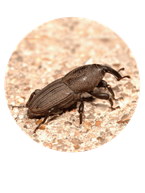The Problem
Annual bluegrass weevil (Listronotus maculicollis) (ABW) severely damages annual bluegrass golf turf in the Northeast U.S. and Mid-Atlantic region, and is gradually spreading west into Ohio and Kentucky and as far south as North Carolina. Experts believe that ABW will continue to spread, especially since it can be transported in sod. Adult ABW overwinter in the top 1-2” of soil, leaf litter, and higher mowed turf, often up to 200 feet away from fairways and into the edges of tree lots. Adults migrate to fairways and tees primarily on foot; thus, migration may be spread out over many weeks due to slow movement, distance to desired turf, and downward spikes in temperature. Peak migration of overwintering adults usually occurs at peak yellow bloom of Forsythia. Overwintering adults will start laying eggs in the turfgrass whorl shortly after full bloom of Forsythia, or when Forsythia is half-yellow, half-green. Larval stages that feed in and on the stems of annual bluegrass are the causal agents of turf damage. In the Northeast US, two generations are typical, but only one generation occurs farther north and up to four generations have been reported farther south.
What to Look For
Adult ABW are small, 1/8-inch long dark gray beetles. Younger beetles are reddish, but will darken within days of hatching. The major distinguishing factor between the ABW and billbugs is that the ABW has the elbowed antennae attached near the snout tip. Adults cause minor damage chewing holes or notches in the turf leaf blades. Adults lay eggs in between leaf sheath and stem, and one female is able to lay 60-90 eggs in her lifetime. Hatching larvae feed inside turfgrass stems and eventually burrow out of the stem, and older larvae live at the soil surface and feed on crowns. Larvae are creamy white with a brown head, ranging from 1/32-inch long as newly hatched instars to 3/16-inch long fully developed instars. Stems break off easily from the root system of damaged plants. Larvae can feed on crowns of multiple plants during their development. Damage typically begins along edges of fairways, greens, and tees, especially next to overwintering areas such as tree lots. Symptoms begin as yellowish to browning spots or small dead patches that eventually coalesce into large areas as larvae develop. Larval densities can exceed 450/sq. foot, with reports of visual damage in Poa annua at 10/sq. ft. and in creeping bentgrass at 160/sq. ft. Symptoms are usually worse from first generation larvae in May and June than second generation larvae in late July and August. Damage from the second generation reaches farther into fairways away from overwintering habitat.
The Solution
Despite the effort to control the pest population under economic threshold, cultural practices maximizing turf health are also critical. If practical, conversion away from annual bluegrass to creeping bentgrass or perennial ryegrass will minimize ABW damage. Adequate fertility and irrigation to promote growth through damage periods is important. Adult ABW can survive mowing, so discard clippings from infested fairways as far away as possible. However, detecting adults in mower baskets can help determine application timing.
Many control tactics start with targeting overwintering adults as they emerge and migrate to fine turf areas. Contact insecticides such as the synthetic pyrethroids have been used to manage adults with some success. For more consistent and reliable control, a program that targets first generation larvae to limit damage — as well as the future generation — is required. Systemic larvicides such as Tetrino® can be highly effective when used in a program. Tetrino is especially useful in controlling both early and late instar larvae, with recommended timing around peak egg lay (late April) through full rhododendron bloom (late May/early June). In areas with high populations, optimal control will usually require a second application of a residual product such as Tetrino in early July to target second generation larvae, which will also help to control white grubs such as Japanese beetles and masked chafers. Insecticide resistance to the synthetic pyrethroids has been documented in some ABW populations, so it is important to rotate modes of action on occasion. A short residual contact product such as Dylox® is highly effective for this purpose and provides excellent control of later instar larvae and adult suppression in situations where asynchronous stages are present.
Additional resources
| Solution sheet - Annual Bluegrass Weevil |









